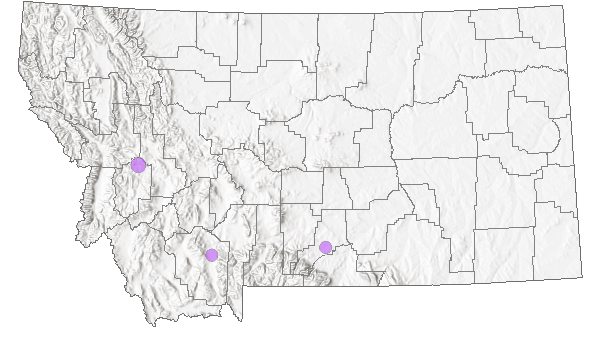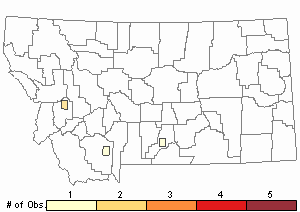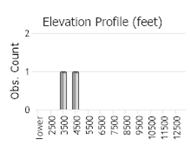View in other NatureServe Network Field Guides
NatureServe
Montana
Utah
Wyoming
Idaho
Wisconsin
British Columbia
South Carolina
Yukon
California
New York
Pale Duckweed - Lemna valdiviana
State Rank Reason (see State Rank above)
Lemna valdiviana is known from one verified location and two unverified locations in Montana and near the border in Yellowstone National Park, Wyoming. In the western U.S. plants are known from widely scattered locations, and apparently are more widespread in the mid-western and eastern U.S. states (Landolt in Flora of North America 2000). Montana's lone verified population occurs in a warm spring, which is a rare habitat, that is subjected to human disturbance. The population has not been surveyed for in more than 20 years. Current data on its presence, population size, and viability are greatly needed.
- Details on Status Ranking and Review
Range Extent
ScoreE - 5,000-20,000 sq km (~2,000-8,000 sq mi)
Comment14,439 square kilometers.
Area of Occupancy
ScoreC - 3-5 4-km2 grid cells
CommentMontana can be divided into 30,390 4x4 square kilometer cells. For this species plant observations occur in 3 of these 4x4 square kilometer cells.
Number of Populations
ScoreA - 1 - 5
Comment4 observations representing 3 locations.
Environmental Specificity
ScoreA - Very narrow. Specialist or community with key requirements scarce
CommentVerified specimens occur in a warm spring.
Threats
ScoreA - Very High
CommentThe single verified population is disturbed by human activity which threatens the plant.
General Description
PLANTS: Perennial, free-floating, aquatic herbs. Individuals are called 'fronds' consisting of part stem and part leaf blade. Plants grow in clusters (colonial). A mother frond attaches to new fronds by a stipe or stalk. Source: Landolt in Flora of North America (FNA) 2000.
FRONDS: Green, oblong, 1-2 mm long, and uniformly thin. Each produces a single root, 1-15 mm long. 1-2 prominent veins extend for three-quarters of the distance between the node and apex. Sources: Lesica et al. 2012; Giblin et al. [eds.] 2018.
INFLORESCENCE: Often absent; when present 1, sometimes 2 bisexual flowers occur in a marginal cleft of the frond. Flowers surrounded by a small utricular, membranous scale. Source: Landolt in FNA 2000.
Lemna is the Greek word for "water plant" and was used by Theophrastus, who often is considered the 'father of botany' (371-287 BC); Lemna might be derived from limne meaning lake which is a common habitat (Giblin et al. [eds.] 2018).
Phenology
Plants very rarely flower, but across its North American distribution flowering occurs from spring to fall (Landolt in FNA 2000).
Diagnostic Characteristics
Montana species of the Duckweed Family are all small, perennial, free-floating, aquatic herbs distinguished by their veins and roots. Veins are best observed using a 10x magnification and back-lighting (Giblin et al. [eds.] 2018) or by placing on a transparent slide (Landolt
in FNA 2000). Landolt
in FNA (2000) provides some techniques to analyze anatomy. In this family the term "leaf" cannot be used because a leaf consists of a stem (petiole) and a blade (Landolt
in FNA 2000). Instead the term "frond" is used. Be aware that species can grow in the same place naturally.
Lemna - Duckweed, native
* Fronds: Green above and mostly below.
* Root: 1 per frond, sometimes absent.
* Veins: 1-3 per frond.
Spirodela - Duck-meal, native
* Fronds: Green above and usually purplish below.
* Roots: 2 or more per frond
* Veins: 3 or more per frond.
Wolffia - Water-meal, native
* Fronds: Green to brown.
* Root: 0; absent.
* Veins: 0; absent.
Pale Duckweed -
Lemna valdiviana, native, SOC
*Fronds: 1-2 mm long, oblong, green on top and bottom.
*Turions: Absent.
*Habitat: Warm Springs; possibly also lakes and rivers.
Inflated Duckweed -
Lemna gibba, native
*Fronds: Less than 6 mm long, nearly oval, greenish on top and bottom or red to purplish on bottom. Red to purple color emanating from the margins.Inflated which can be seen in cross-section, making their lower surface convex.
*Turions: Absent.
*Habitat: Calm waters of ponds and lakes.
Lesser Duckweed -
Lemna minor, native
*Compare to
Lemna turionifera.
*Fronds: at least some are more than 2 mm long, roundish, green on top and often purplish on bottom.
*Turions: Absent.
*Fruit: 0.8-1mm long. Seeds with 8-15 distinct ribs.
*Habitat: Permanent, slow moving water of ponds, lakes, and streams.
Star Duckweed -
Lemna triscula, native
*Fronds: 6-12 mm long, oblong to lanceolate and attached together by elongated stipes to appear like a 'canoe paddle', and greenish on top and bottom.
*Turions: Absent.
*Veins: 3 and faint.
*Habitat: Fresh to somewhat alkaline water of ponds, lakes, and marshes.
Turion Duckweed -
Lemna turionifera, native
*Compare to
Lemna minor.
*Fronds: 1-4 mm long, nearly oval, flat, green on top and bottom, sometimes red to purplish on bottom. Red to purple color emanating from the root.
*Turions: Produced under stress. Olive, brown, or dark green rootless disk-like, 0.8-1.6 mm wide, that sink.
*Fruit: 0.5-0.6 mm long. Seeds with 30-60 distinct ribs.
*Habitat: Calm waters.
Species Range
Montana Range
Range Descriptions

 Native
Native
Range Comments
Western Montana, central Idaho, and southeast Oregon, across to central and southern United States into Mexico, Central America, and South America (Giblin et al. [eds.] 2018).
Pale Duckweed is considered rare in Yellowstone National Park (Hellquist et al. 2014). It has been found in a warm spring along Firehole River in Yellowstone National Park.
Observations in Montana Natural Heritage Program Database
Number of Observations: 4
(Click on the following maps and charts to see full sized version)
Map Help and Descriptions
Relative Density

Recency



 (Observations spanning multiple months or years are excluded from time charts)
(Observations spanning multiple months or years are excluded from time charts)
Habitat
Montana's verified plants floating on the water's surface at a warm spring (Lesica et al. 2012). Montana's unverified plants were found in a lake and at a fishing access site on a river (
https://www.pnwherbaria.org/ as of September 8, 2020).
Ecology
GROWTH
Duckweed plants that grow in shaded habitats may be twice the size of those growing in full sun (Giblin et al. [eds.] 2018). Members of the Duckweed Family have a high productivity rate with particular species able to double their population with a 24-hour window (Landolt in FNA 2000). Species of the Duckweed Family tend to be very rare in places with high or very low precipitation (Landolt in FNA 2000).
PLANT-ANIMAL INTERACTIONS
Plants in the Duckweed Family are easily transplanted over short distances by birds (Landolt in FNA 2000). Duckweed species have a high nutritive value with up to 45% of their dry weight consisting of amino acids, the building blocks for protein (Landolt in FNA 2000; Culver and Lemly 2013). They provide food for fish, snapping turtles, and waterfowl and create habitat for aquatic invertebrates (Culver and Lemly 2013). Certain species are cultivated as feed for poultry, pegs, and cows (Landolt in FNA 2000).
Reproductive Characteristics
Of all the flowering plants, members of the Duckweed Family are the smallest and have the most reduced flowering parts (Landolt in FNA 2000). For most species in the Duckweed Family, flowering and fruiting is a rarity, but cloning is common (Landolt in FNA 2000). There are few characteristics noticeable to humans that help separate the species (Landolt in FNA 2000). Many morphological features are modified among the species.
FLOWER
Sepals and petals are absent. Stamen number is 1-2. Ovary is single with 1 cavity (locule) and is bottle-shaped, tapering into short styles and a funnel-shaped stigma.
FRUIT
Follicle is 1-1.35 mm long and lacks a wing. Follicle burst opens to disperse 1-5 long-shaped seeds (Landolt in FNA 2000). Seeds have 15-29 distinct ribs.
LIFE CYCLE
Although plants are perennial, species of Duckweed live only as long as the conditions are favorable (Landolt in FNA 2000). Pale Duckweed populations could persist longer than other species because it can live in a warm spring (Landolt in FNA 2000). Populations move around over time, often facilitated by animal transport.
Management
Surveys are needed to obtain current data on the presence, locations, abundance, and viability of Pale Duckweed.
Species of the Duckweed Family are used for waste-water purification and as test- and indicator- plants for detecting certain conditions (Landolt in FNA 2000).
Stewardship Responsibility
Threats or Limiting Factors
STATE THREAT SCORE REASON
Reported threats to Montana's populations of Pale Duckweed are currently assigned as unknown (MTNHP Threat Assessment 2021).
References
- Literature Cited AboveLegend:
 View Online Publication
View Online Publication Culver, D. and J. Lemly. 2013. Field Guide to Colorado's Wetland Plants: Identification, Ecology and Conservation. Fort Collins, CO: Colorado Natural Heritage Program. 694 p.
Culver, D. and J. Lemly. 2013. Field Guide to Colorado's Wetland Plants: Identification, Ecology and Conservation. Fort Collins, CO: Colorado Natural Heritage Program. 694 p. Flora of North America Editorial Committee (FNA). 2000. Flora of North America north of Mexico. Vol. 22. Magnoliophyta: Alismatidae, Arecidae, Commelinidae (in part), and Zingiberidae. Oxford Univ. Press, New York. xxiii + 352 pp.
Flora of North America Editorial Committee (FNA). 2000. Flora of North America north of Mexico. Vol. 22. Magnoliophyta: Alismatidae, Arecidae, Commelinidae (in part), and Zingiberidae. Oxford Univ. Press, New York. xxiii + 352 pp. Hellquist, C.E., C. Barre Hellquist, and J.J. Whipple. 2014. New Records for Rare and under-Collected Aquatic Vascular Plants of Yellowstone National Park, Madrono Vol. 61, No. 2, pp. 159-176.
Hellquist, C.E., C. Barre Hellquist, and J.J. Whipple. 2014. New Records for Rare and under-Collected Aquatic Vascular Plants of Yellowstone National Park, Madrono Vol. 61, No. 2, pp. 159-176. Hitchcock, C.L. and A. Cronquist. 2018. Flora of the Pacific Northwest: An Illustrated Manual. Second Edition. Giblin, D.E., B.S. Legler, P.F. Zika, and R.G. Olmstead (eds). Seattle, WA: University of Washington Press in Association with Burke Museum of Natural History and Culture. 882 p.
Hitchcock, C.L. and A. Cronquist. 2018. Flora of the Pacific Northwest: An Illustrated Manual. Second Edition. Giblin, D.E., B.S. Legler, P.F. Zika, and R.G. Olmstead (eds). Seattle, WA: University of Washington Press in Association with Burke Museum of Natural History and Culture. 882 p. Lesica, P., M.T. Lavin, and P.F. Stickney. 2012. Manual of Montana Vascular Plants. Fort Worth, TX: BRIT Press. viii + 771 p.
Lesica, P., M.T. Lavin, and P.F. Stickney. 2012. Manual of Montana Vascular Plants. Fort Worth, TX: BRIT Press. viii + 771 p. MTNHP Threat Assessment. 2021. State Threat Score Assignment and Assessment of Reported Threats from 2006 to 2021 for State-listed Vascular Plants. Botany Program, Montana Natural Heritage Program, Helena, Montana.
MTNHP Threat Assessment. 2021. State Threat Score Assignment and Assessment of Reported Threats from 2006 to 2021 for State-listed Vascular Plants. Botany Program, Montana Natural Heritage Program, Helena, Montana.
- Additional ReferencesLegend:
 View Online Publication
View Online Publication
Do you know of a citation we're missing? Lesica, P., M.T. Lavin, and P.F. Stickney. 2022. Manual of Montana Vascular Plants, Second Edition. Fort Worth, TX: BRIT Press. viii + 779 p.
Lesica, P., M.T. Lavin, and P.F. Stickney. 2022. Manual of Montana Vascular Plants, Second Edition. Fort Worth, TX: BRIT Press. viii + 779 p.
- Web Search Engines for Articles on "Pale Duckweed"





